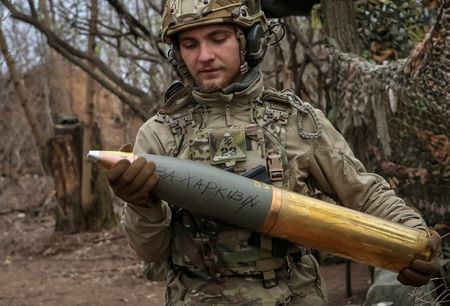By Phil Stewart and Idrees Ali
WASHINGTON (Reuters) – The United States hopes its new deliveries of weaponry will help Ukraine rebuild defenses and refit its forces as it recovers from a gap in U.S. assistance, but it does not expect Kyiv to launch large-scale offensive operations against Russian forces in the near term, a U.S. defense official said on Thursday.
The U.S. will on Friday host a virtual meeting of Ukraine international aid donors, days after Congress emerged from a half-year of deadlock to approve a $61 billion aid package for Ukraine. President Joe Biden’s administration quickly announced $1 billion in artillery, air defenses and other hardware would soon be heading to Ukrainian front lines.
The influx of weapons could improve Kyiv’s chances of averting a major Russian breakthrough in the east, just over two years since the start of Moscow’s full-scale invasion, military analysts say.
But it remains unclear how much pressure Kyiv can apply on Russia after months of rationing artillery as its stocks ran low. Kyiv also faces manpower shortages on the battlefield and questions linger over the strength of its fortifications along a sprawling, 1,000-km (621-mile) front line.
The U.S. defense official, speaking on condition of anonymity, said the goal was to enable Ukraine so that its forces would be able to “regain the initiative.””In terms of what we see in the next several months of operations, Ukrainians will need to rebuild quite a bit to take on board all of these new supplies after having rationed ammunition and other supplies … and ensure that they can defend their positions,” the official said.
“So I would not forecast any large-scale offensive in the near term,” the official said, while expressing optimism that Kyiv would be able to start applying “significantly greater pressure” on Russian forces including in Russian-occupied Crimea.
HALTING RUSSIA’S INITIATIVE
Moscow has had the battlefield advantage since capturing the long-time bastion town of Avdiivka in the eastern Donbas region in February, and its forces have been slowly advancing using greater numbers of troops and artillery shells.
They are now bearing down on the town of Chasiv Yar, located on high ground that, if captured, would bring Moscow closer to the remaining Kyiv-held Donbas cities of Kostiantynivka, Kramatorsk and Sloviansk.
Zelenskiy said this month that Russia was now able to fire 10 times more artillery rounds than Ukraine’s troops. Russian forces outnumber Kyiv’s troops 7-10 times in the east, a Ukrainian general said this month.
U.S. officials have said for months that new U.S. aid was critical, even if Ukraine might take time to rebuild momentum.
Air Force General C.Q. Brown, chairman of the Joint Chiefs of Staff, told a forum at Georgetown University that Kyiv had in the past proved it could use U.S. assistance effectively, and said its troops had recovered half of the territory seized by Russian forces at the start of their invasion.
“Why this aid for Ukraine is so important is because when they’re provided with capability, they’ve been effective,” Brown said.
Biden, a Democrat who is expected to face Republican former President Donald Trump in the November presidential election, had pressed lawmakers for six months to approve more funding for Ukraine.
Trump objected to the Ukraine aid, and some Republicans in Congress refused to back it, questioning whether Ukraine could ever prevail.
The U.S. defense official, briefing a small group of reporters, did not directly address a question about whether allies should do more to soften any future impact from U.S. political volatility on Ukraine aid but expressed optimism about long-term support for Kyiv.
“We’re really pleased to see that we have solid bipartisan support for Ukraine,” the official said. “There has been really very steady support from the allies over the course of the past … year. And we’re foreseeing that support continuing.”
In addition to U.S. aid, the European Union is providing assistance including a Czech-led initiative that will begin supplying Ukraine with some 300,000 rounds of 155 mm artillery shells from June.
Germany also announced plans in April to supply a U.S.-made Patriot air defense system and air defense missiles.
(Reporting by Phil Stewart and Idrees Ali, Editing by Timothy Heritage)




